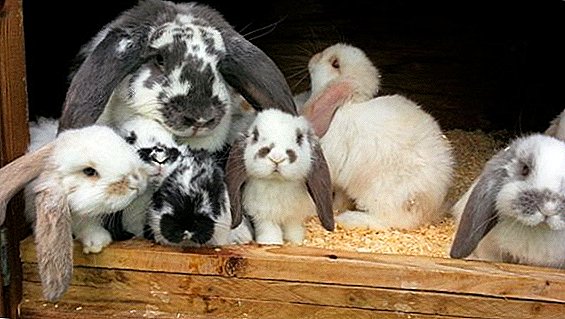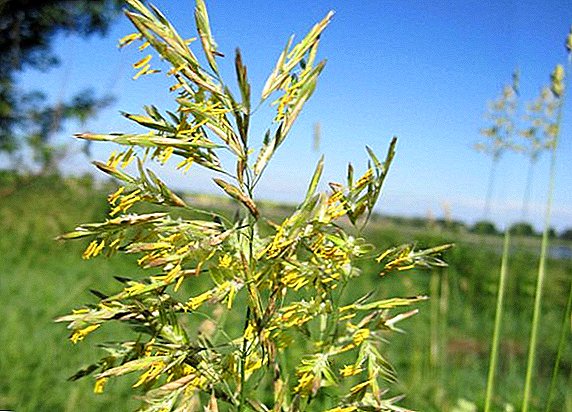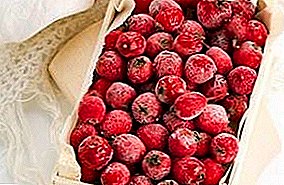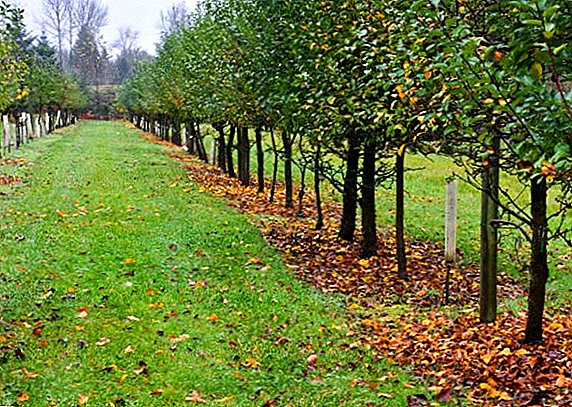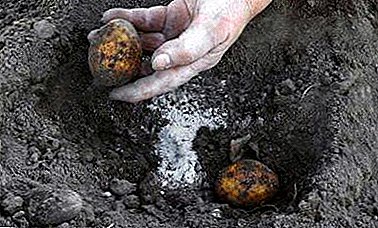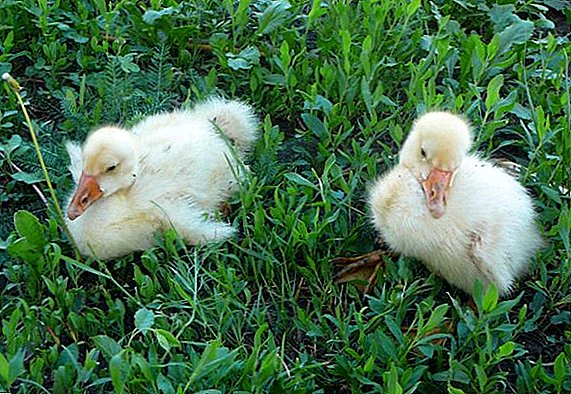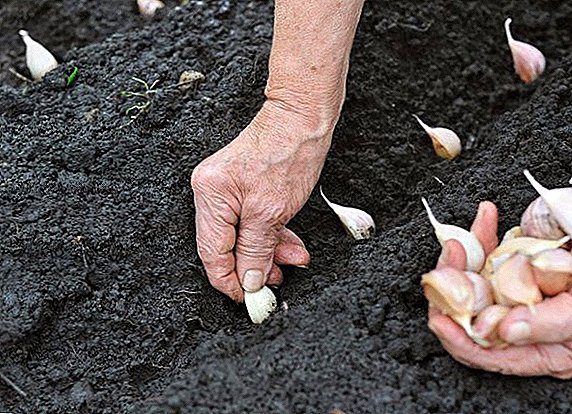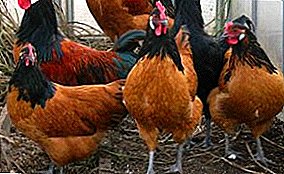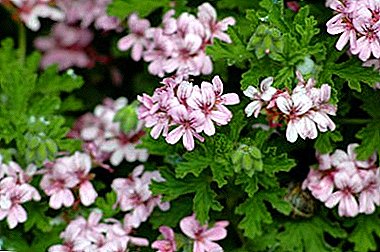
The attention of any resident of the metropolis is attracted by bright and lush flowers that adorn buildings and flower beds and create a festive mood.
But not everyone knows what kind of plant it is, where it comes from. And those who decided to purchase this flower for themselves do not even know how reproduction and cultivation take place, and what kind of care it needs. In all these questions will help to understand this article.
Description and price
 Ampel pelargonium is a perennial plant of the genus Geraniah.. A feature of this plant species is the long shoots and inflorescences of the umbrella type in the form of a single bundle, consisting of 5 to 15 flowers. The inflorescence is located on a long peduncle, the inflorescence diameter is 8-10 cm. The leaf plate of pelargonium has a palmate-lobed shape.
Ampel pelargonium is a perennial plant of the genus Geraniah.. A feature of this plant species is the long shoots and inflorescences of the umbrella type in the form of a single bundle, consisting of 5 to 15 flowers. The inflorescence is located on a long peduncle, the inflorescence diameter is 8-10 cm. The leaf plate of pelargonium has a palmate-lobed shape.
The native land of ampelous pelargonium is the Cape Province of South Africa, where it naturally falls cascades from the hillsides. In the 17th century it was brought to Holland, and from there the flower was sold throughout Europe as early as the 17th and 18th centuries. Pricing policy for those wishing to purchase this plant is as follows:
- in Moscow rooted cuttings of ampelous pelargonium, which do not require transplantation, are sold for 450 rubles. apiece, and the price for an adult plant can reach 800 rubles;
- in St. Petersburg rooted cutting costs 250 - 300 rubles, an adult plant - 450 rubles.
Appearance and features of flowering
The peculiarity of the ampelous pelargonium is the falling shoots, the length of which can be from one to one and a half meters. The shoots are able to curl on the walls or hang down effectively, so the plant is actively used for vertical gardening.
The color palette of inflorescences is diverse: ampelous flowers of pelargonium can be white, purple, scarlet, red, pink. The tone can be non-uniform: there are varieties in which the flowers are speckled, striped, with a border and spots. Flowers can be simple and terry.
Duration of flowering each - 5 - 6 days. Flowering time - from mid-spring to mid-summer. The glossy leaves of the plant are five-lobed, their width is 3–6 cm. Their color is interesting: depending on the variety, it may be of a saturated green color or white-and-white color.
In the 18th century, flower growers and breeders in England and the Netherlands developed a plant species that was very similar to African pelargonium. He was called geraniums. Karl Linney in his treatise "The System of Nature" combined them into one genus. But African and European plants have a different flower structure and other differences, therefore, in the modern classification, geranium and geranium are representatives of different genera. Hence the confusion in many information sources that mistakenly replace one name with another.
Geranium and pelargonium - two different plants!
A photo
Next, look at photos of different varieties of the flower.





Common species of the genus
The most common species in Russia are:
- Zonal
- Royal
- Variegated.
- Scented.
- Prickly.
But only the ivy form (ivy-shaped) or ampelous pelargonium has the ability to shoot or creep down. The name of the plant acquired due to the external similarity of the leaves of this type of pelargonium with ivy leaves (five-lobed, hard and smooth).
Word "Ampel" in German means "hanging vase for flowers". Hence the interchangeability of the names: they all call the plant, whose shoots are able to weave, like the shoots of ivy, so it is advisable to grow them in hanging pots or pots. However, some landscape designers use ivy-like pelargonium and as a ground-covering culture.
Basic rules for planting a flower
The basic rules and tips that you may need when planting an ampel pelargonium:
- For planting of ampella pelargonium, hanging pots, baskets, high-stem pots or boxes, which will be mounted on a balcony or a window, are necessary.
- In advance it is necessary to think over the system of fastening these tanks to the walls, awnings, windows, balconies.
- The optimal time for planting ampelous pelargonium is spring or early autumn.
- If the plants are planted in one row, then the distance between them should be about 15 cm.
- Pelargonium pot should be a little cramped: if it is voluminous, then the root system of the plant will tend to fill all the free space, and will not “have enough strength” for flowering.
- It is necessary to replant the ivy geranium with a frequency of 1 time in 2 years.
Landing instructions
 Prepare everything you need: capacity, sapling (preferably several for a beautiful bush form) ampelous pelargonium, drainage, soil, watering can, scapula.
Prepare everything you need: capacity, sapling (preferably several for a beautiful bush form) ampelous pelargonium, drainage, soil, watering can, scapula.- The pot is filled with a layer of drainage (approximately 1/4 of the total volume) and soil.
- In the tank, the shovels are alternately made recesses, in which pelargonium seedlings are immersed at the same distance from each other.
- Each seedling is covered with earth, which should be pressed tightly at the base of the shoot for better fixation.
- The plant must be watered.
Ampel pelargonium does not tolerate stagnant moisture in the pot, which can provoke the rotting of its roots. Therefore, you should not forget about the drainage in the pot (expanded clay, crushed brick, broken foam, etc.), as well as the drainage holes in the bottom of the tank, designed to drain excess fluid.
Lighting and location
Ampelnaya pelargonium loves the bright sunIt requires a sufficiently long light day for full development (about 16 hours). The flower is relatively easy to tolerate dry periods, and feels great outdoors. The best place to stay Pelargonium in the warm season will be balconies, windows, gazebos, terraces or flowerpots, exhibited on the garden. Desirable direction - south, southeast, southwest.
Soil requirements
Soil, optimally suitable for planting an ampel pelargonium, should possess such characteristics as looseness, lightness, air and moisture permeability. A mandatory element of the substrate, providing all these requirements, is peat and coarse sand. Ready soil can be bought in a store or prepared by your own: in a ratio of 1: 1: 1: 1 mix peat, sand, turf, leaf soil.
Cultivation and care at home
- Watering. As with any plant, ampella pelargonium needs moisture. But it should not be too much. Watering should be systematic and moderate, the frequency of watering - as the upper layer of soil dries out (2 times a week). In winter, during the dormant period, watering is rare (1 time in 2 weeks).
The flower does not tolerate spraying! Such a procedure can provoke a number of diseases in the plant.
- Temperature. For high-grade growth of pelargonium, a sufficiently high temperature is necessary - + 20С - + 25С. In winter, during the dormant period of the plant, the thermometer in the room where the flower will be stored should not show a mark above + 10С - + 12С.
- Top dressing. In spring and summer, the plant needs nutrition. It is appropriate to apply fertilizers containing a large percentage of nitrogen at the beginning of the season to increase the green mass of pelargonium, and during the flowering period fertilizers should be rich in potassium and phosphorus. Periodic feedings - 1 time in 10 days.
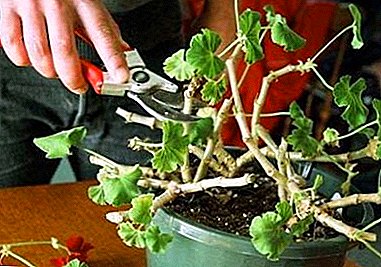 Pruning. In autumn, the bush of ampelous pelargonium needs pruning not only for aesthetic reasons, but also for the plant to remain healthy. Pruning should be deep: do not touch only those shoots that came out of the root or have no more than 7 leaves on themselves. Removed dried whips, as well as those shoots that came out of the leaf bosoms.
Pruning. In autumn, the bush of ampelous pelargonium needs pruning not only for aesthetic reasons, but also for the plant to remain healthy. Pruning should be deep: do not touch only those shoots that came out of the root or have no more than 7 leaves on themselves. Removed dried whips, as well as those shoots that came out of the leaf bosoms.- Wintering. From late autumn to early spring, ampella pelargonium enters a period of rest. She needs a rather low temperature (+ 10С - + 12С), rare watering and the absence of any manipulations with her. It is better if the plant is taken out into the utility room corresponding to the recommended temperature regime, or a glazed but unheated balcony. In the case of overwintering the plants in room conditions, flowering may not occur.
Diseases and pests
The most common diseases of ampelous pelargonium:
- root rot (from excessive watering and hypothermia);
- powdery mildew;
- rust;
- spotting
They can be provoked by bacteria and infections that have fallen into the soil and on the plant itself.
Of the pests attacking the flower, the most frequent are:
- aphid;
- pincers;
- caterpillars.
At the first signs of damage, the plant must be isolated from the others, the diseased leaves removed and burned, and the pelargonium must be treated with a fungicide. You should also review the scheme of care for the flower. If a copy cannot be saved, it should be destroyed along with the ground.
Breeding features
 Ampel pelargonium multiplies seeds, cuttings, dividing the bush. The most common breeding method is grafting.
Ampel pelargonium multiplies seeds, cuttings, dividing the bush. The most common breeding method is grafting.
It is quite simple (even a novice grower can handle it), is quick (in a month a rooted sprout can release its own roots) and is effective (a seedling inherits all the varietal traits of the mother plant).
Grafting - vegetative propagation of a plant with a cutting. The stalk is the separated part of the plant. The cuttings of ampelous pelargonium are made in spring.
- The tops of young shoots (7–10 cm) with two pairs of healthy and strong leaves are cut off from the plant.
- Dried in a few hours.
- They penetrate into a moist, loose soil by 3-4 cm.
- The container is set on the illuminated place, but without direct sunlight, it is periodically watered as the soil dries.
It is possible for a young plant to create additional shelter, but this will require a nonwoven material that is not able to form condensate.
Rooting in the water will not lead to a successful ending: the stalk will simply rot. In about a month, rooted cuttings can be transplanted in individual pots.
We offer to watch a video on the reproduction of ampelous pelargonium:
Ampel pelargonium - truly a beautiful flower. She is a bit capricious, but a caring owner for all the troubles will surely generously reward her abundant flowering.


 Prepare everything you need: capacity, sapling (preferably several for a beautiful bush form) ampelous pelargonium, drainage, soil, watering can, scapula.
Prepare everything you need: capacity, sapling (preferably several for a beautiful bush form) ampelous pelargonium, drainage, soil, watering can, scapula. Pruning. In autumn, the bush of ampelous pelargonium needs pruning not only for aesthetic reasons, but also for the plant to remain healthy. Pruning should be deep: do not touch only those shoots that came out of the root or have no more than 7 leaves on themselves. Removed dried whips, as well as those shoots that came out of the leaf bosoms.
Pruning. In autumn, the bush of ampelous pelargonium needs pruning not only for aesthetic reasons, but also for the plant to remain healthy. Pruning should be deep: do not touch only those shoots that came out of the root or have no more than 7 leaves on themselves. Removed dried whips, as well as those shoots that came out of the leaf bosoms.